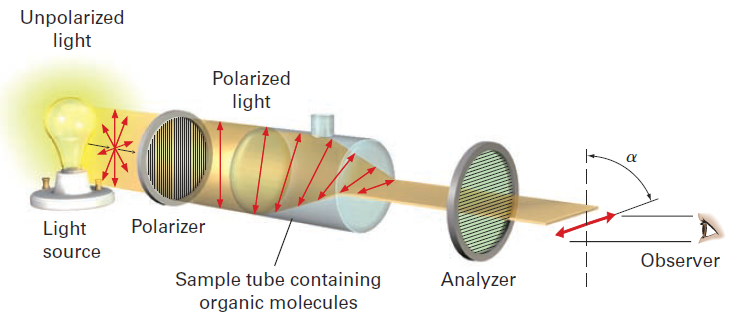

علم الكيمياء

تاريخ الكيمياء والعلماء المشاهير

التحاضير والتجارب الكيميائية

المخاطر والوقاية في الكيمياء

اخرى

مقالات متنوعة في علم الكيمياء

كيمياء عامة


الكيمياء التحليلية

مواضيع عامة في الكيمياء التحليلية

التحليل النوعي والكمي

التحليل الآلي (الطيفي)

طرق الفصل والتنقية


الكيمياء الحياتية

مواضيع عامة في الكيمياء الحياتية

الكاربوهيدرات

الاحماض الامينية والبروتينات

الانزيمات

الدهون

الاحماض النووية

الفيتامينات والمرافقات الانزيمية

الهرمونات


الكيمياء العضوية

مواضيع عامة في الكيمياء العضوية

الهايدروكاربونات

المركبات الوسطية وميكانيكيات التفاعلات العضوية

التشخيص العضوي

تجارب وتفاعلات في الكيمياء العضوية


الكيمياء الفيزيائية

مواضيع عامة في الكيمياء الفيزيائية

الكيمياء الحرارية

حركية التفاعلات الكيميائية

الكيمياء الكهربائية


الكيمياء اللاعضوية

مواضيع عامة في الكيمياء اللاعضوية

الجدول الدوري وخواص العناصر

نظريات التآصر الكيميائي

كيمياء العناصر الانتقالية ومركباتها المعقدة


مواضيع اخرى في الكيمياء

كيمياء النانو

الكيمياء السريرية

الكيمياء الطبية والدوائية

كيمياء الاغذية والنواتج الطبيعية

الكيمياء الجنائية


الكيمياء الصناعية

البترو كيمياويات

الكيمياء الخضراء

كيمياء البيئة

كيمياء البوليمرات

مواضيع عامة في الكيمياء الصناعية

الكيمياء الاشعاعية والنووية
Optical Activity
المؤلف:
John McMurry
المصدر:
Organic Chemistry
الجزء والصفحة:
9th - p121
31-5-2016
4124
Optical Activity
The study of chirality originated in the early 19th century during investigations by the French physicist Jean-Baptiste Biot into the nature of planepolarized light. A beam of ordinary light consists of electromagnetic waves that oscillate in an infinite number of planes at right angles to its direction of travel. When a beam of ordinary light passes through a device called a polarizer, however, only the light waves oscillating in a single plane pass through and the light is said to be plane-polarized. Light waves in all other planes are blocked out.
Biot made the remarkable observation that when a beam of planepolarized light passes through a solution of certain organic molecules, such as sugar or camphor, the plane of polarization is rotated through an angle, a. Not all organic substances exhibit this property, but those that do are said to be optically active.
The angle of rotation can be measured with an instrument called a polarimeter, represented in Figure 1-1. A solution of optically active organic molecules is placed in a sample tube, plane-polarized light is passed through the tube, and rotation of the polarization plane occurs. The light then goes through a second polarizer called the analyzer. By rotating the analyzer until the light passes through it, we can find the new plane of polarization and can tell to what extent rotation has occurred.

Figure 1-1 Schematic representation of a polarimeter. Plane-polarized light passes through a solution of optically active molecules, which rotate the plane of polarization.
In addition to determining the extent of rotation, we can also find the direction. From the vantage point of the observer looking directly at the analyzer, some optically active molecules rotate polarized light to the left (counterclockwise) and are said to be levorotatory, whereas others rotate polarized light to the right (clockwise) and are said to be dextrorotatory.
By convention, rotation to the left is given a minus sign (-) and rotation to the right is given a plus sign (+). (-)-Morphine, for example, is levorotatory, and (+)-sucrose is dextrorotatory. The extent of rotation observed in a polarimetry experiment depends on the number of optically active molecules encountered by the light beam. This number, in turn, depends on sample concentration and sample pathlength. If the concentration of the sample is doubled, the observed rotation doubles. If the concentration is kept constant but the length of the sample tube is doubled, the observed rotation doubles. It also happens that the angle of rotation depends on the wavelength of the light used.
To express optical rotations in a meaningful way so that comparisons can be made, we have to choose standard conditions. The specific rotation, [α]D, of a compound is defined as the observed rotation when light of 589.6 nanometer (nm; 1 nm = 10-9 m) wavelength is used with a sample pathlength l of 1 decimeter (dm; 1 dm = 10 cm) and a sample concentration c of 1 g/cm3. (Light of 589.6 nm, the so-called sodium D line, is the yellow light emitted from common sodium street lamps.)

When optical rotation data are expressed in this standard way, the specific rotation, [α]D, is a physical constant characteristic of a given optically active compound. For example, (+)-lactic acid has [α]D = -3.82, and (-)-lactic acid has [α]D = +3.82. That is, the two enantiomers rotate planepolarized light to exactly the same extent but in opposite directions. Note that the units of specific rotation are [(deg · cm2)/g] but that these values are usually expressed without units. Some additional examples are listed in Table 1.
Table 1:

 الاكثر قراءة في مواضيع عامة في الكيمياء العضوية
الاكثر قراءة في مواضيع عامة في الكيمياء العضوية
 اخر الاخبار
اخر الاخبار
اخبار العتبة العباسية المقدسة

الآخبار الصحية















 قسم الشؤون الفكرية يصدر كتاباً يوثق تاريخ السدانة في العتبة العباسية المقدسة
قسم الشؤون الفكرية يصدر كتاباً يوثق تاريخ السدانة في العتبة العباسية المقدسة "المهمة".. إصدار قصصي يوثّق القصص الفائزة في مسابقة فتوى الدفاع المقدسة للقصة القصيرة
"المهمة".. إصدار قصصي يوثّق القصص الفائزة في مسابقة فتوى الدفاع المقدسة للقصة القصيرة (نوافذ).. إصدار أدبي يوثق القصص الفائزة في مسابقة الإمام العسكري (عليه السلام)
(نوافذ).. إصدار أدبي يوثق القصص الفائزة في مسابقة الإمام العسكري (عليه السلام)


















